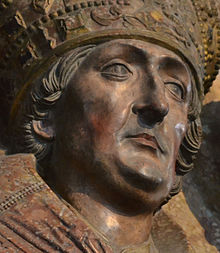Lorenz von Bibra | |
|---|---|
| Prince-Bishop of Würzburg | |
 Detail of tomb by Tilman Riemenschneider in Würzburg Dom (cathedral) (c. 1460 - July 7, 1531) in Würzburg Dom (cathedral) | |
| See | Würzburg |
| Appointed | 10 July 1495 |
| Installed | 11 October 1495 |
| Term ended | 6 February 1519 |
| Predecessor | Rudolf von Scherenberg |
| Successor | Koenrad von Thüngen |
| Orders | |
| Consecration | 11 October 1495 by Heinrich Groß von Trockau |
| Personal details | |
| Born | 1459 |
| Died | 6 February 1519 (aged 59–60) Würzburg |
| Denomination | Roman Catholic |
| Coat of arms |  |





Lorenz von Bibra, Duke in Franconia (1459, Mellrichstadt – 6 February 1519, Würzburg) was Prince-Bishop of the Bishopric of Würzburg from 1495 to 1519. His life paralleled that of Maximilian I (1459–1519), who ruled the Holy Roman Empire from 1493 to 1519, whom Lorenz served as an advisor.
Born in 1459, he attended school at Vessra Abbey and university at Heidelberg, Erfurt, and Paris. In 1487 he wrote a letter of introduction to Pope Innocent VIII for his half brother Wilhelm who was being sent to the Vatican as emissary of Archbishop Hermann IV of Cologne. In 1490, Wilhelm became ill and died when returning from Rome as an emissary of Frederick III, Holy Roman Emperor. The grave of Wilhelm von Bibra is still to be seen in the Pelligrini Chapel of the Santa Anastasia Church in Verona.
Lorenz was a popular and well respected ruler. He was often called upon to serve as an arbitrator to solve disputes. An adherent of the German humanism movement of the late 15th and early 16th centuries and renaissance man, he sought to bring reforms to the Catholic Church from within.